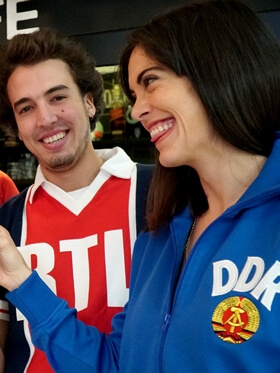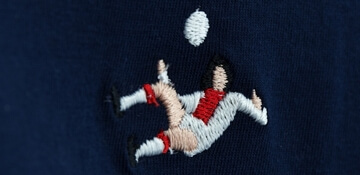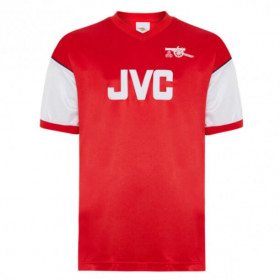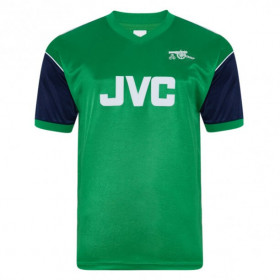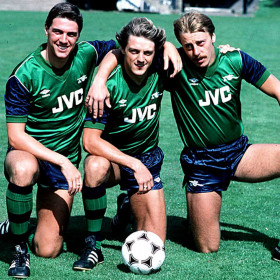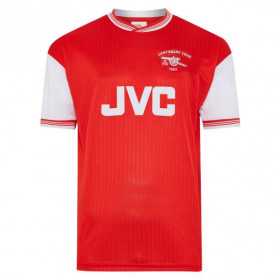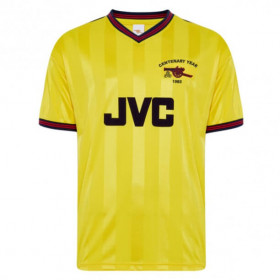Arsenal FC Retro Shirts

Arsenal Football Club, founded in 1886, is one of the great clubs in England. Arsenal FC's record confirms this statement: 13 Premier Leagues, 14 FA Cups, 2 League Cups, 1 European Cup Winners' Cup. The team was a finalist in the Champions League in 2006 and in the UEFA Europa League in 2000 and 2019. Arsenal is also one of the clubs with one of the largest fan bases in the world. .
At Retrofootball® we present the official models of classic Arsenal jerseys that symbolize historic moments of the London club:
- Arsenal 1982 retro shirt
- Arsenal 1985-86 Centennial Retro Shirt
- Arsenal 1985-86 Centennial Away Retro Shirt
We invite you to get your Arsenal shirt and follow the best moments of the Premier League with the vintage style of the great legends. Get the history of football in your own skin!
A brief history of Arsenal
The birth of Arsenal FC
Arsenal was created in 1886 by a group of factory workers. The name was originally Dial Square due to the sundial that they walked underneath every day at the factory. On December 11th, the club won their first game in a 6-0 thrashing.
The classic red Arsenal kit was there from the very start. The very first Arsenal kit was in fact a spare Nottingham Forest kit. This was because a few of the early Arsenal players had connections with Forest and they were kindly lent the kit.
The beginnings of the club
Firstly, the club, that had been renamed to Royal Arsenal, was purely amateur. They competed in and won the London Charity Cup and the London Senior Cup and played in the FA Cup for the first time in 1889. However, with professional teams playing and even trying to poach players, they did not really stand a chance to win.
For this reason, Royal Arsenal became a professional team in 1891, meaning that the players were paid to play. This meant that they couldn’t play in all amateur competitions for two years. Arsenal only had FA Cup and friendly matches. In 1893, now under the name of Woolwich Arsenal, they became the first southern club to become a part of the Football League.
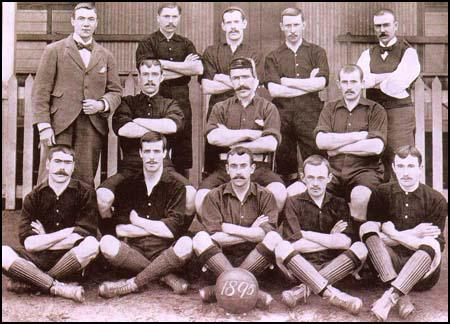
Arsenal 1895 team
For the first eleven seasons, Arsenal finished in the middle of the table but in 1904 they were promoted to First Division. They also reached the semi finals of the FA Cup in 1906 and 1907, but the next decade were still very precarious due to financial difficulties.
The home stadium was quite remote which meant that attendance was dwindling as performances worsened. Sir Henry Norris solved this issue by making the move to Highbury at considerable cost to himself in 1913. The next year, Woolwich was removed from the name and the club was now named Arsenal.
The beginning of a bitter rivalry
Arsenal’s biggest rival is of course Tottenham Hotspur. They are the two biggest clubs in North London, which sparks territorial disputes but there are also other reasons for this rivalry.
After the First World War, the First Division expanded from 20 teams to 22, and an AGM was organised to decide the two new teams that would be added. Chelsea and Tottenham were relegated in the last season, and Chelsea was given one of the two spots was given to them, but a vote was organised for the second position.
Arsenal won this vote and it caught all the other clubs by surprise, especially Tottenham who came second in the vote. Allegations of bribery were never proven but likely. Arsenal have never been relegated since then, the longest serving team of the English top division.
The manager Herbert Chapman and the modernisation of the Club from 1925
The first few seasons in the First Division were not successful with relegation battles taking place every season for the Gunners. The appointment of Herbert Chapman however was set to change all of that and set Arsenal on a more successful course.
He was named as manager in 1925 and modernised the club massively. Training regimes were far more effective and serious, physiotherapy helped the players a lot and Arsenal became a more dangerous outfit.
The classic Arsenal kit went under two major changes under Chapman. The first was in 1928 when he added numbers to players shirts and secondly in 1933 when white sleeves were added to the iconic red shirt. Before then, the kit had been all right with various colours for shorts and socks, but the white sleeves have appeared on virtually every shirt since then.
In 1930, Arsenal won the FA Cup for the first time, the first major trophy of the club’s history. A league victory followed the next season and another title came to Arsenal’s football team soon after. Unfortunately, Chapman died unexpectedly of pneumonia in 1934. He was the team’s first manager to bring considerable success to the club.
The great period of League titles; the 1930’s
Arsenal were the dominant team in England at this point. Having won the title in 1933 and 1934, the title was also won in 1935 that makes them one of only four teams to get three championships in a row.
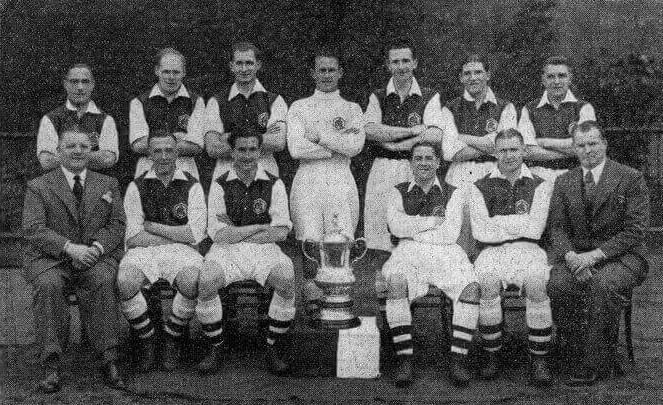
Arsenal 1935/36 Team FA Cup
Ted Drake was one of Arsenal’s team’s main players, netting an incredible 42 times in a single league season, the season finishing in 1935, a record that stands today for the club and is unlikely to change anytime soon since there are only twenty teams in the Premier League.
Arsenal’s dominance of English football can be clearly seen by the lineup against the world Champions Italy in 1934: seven of the starting eleven were Arsenal players, including Ted Drake. No substitutions were allowed as England won the “Battle of Highbury” against the italian team, as it has since been dubbed with a score of 3-2.
The dominance of the Gunners started to fade in 1935 but a league title still came back to Highbury in 1938, and then the Second World War cancelled all of football in England.
After the war
At the end of the war, Arsenal’s football team was largely composed of the same players and had the same manager at the helm, but the dominance was not going to return to the same extent. The London club still won the league in 1948 as well as the 1950 FA Cup.
The star of that team was Joe Mercer. He was a strong tackling defender who had an exceptional attitude and a very good ability to read the game. He was the leader on the pitch, becoming captain almost immediately, and he was the catalyst for the titles and the FA Cup that Arsenal won during this time.
In 1953, Arsenal’s team won the league again by the narrowest margin in history. A completely identical record to Preston in terms of results meant that the title would be decided by goal on goal average, which Arsenal won by 0.099. This was the Gunners’ last trophy for the next seventeen years.
The great 1970s
After a period of mediocrity, Arsenal’s football team was starting to improve considerably in the late 60s. The 1970-71 season proved to be the one in which the Gunners made history. They won the league on the final day versus Leeds in a game that took place at White Hart Lane, just to make the victory that little bit sweeter.
Five days after the win against Leeds, Arsenal were playing Liverpool in the FA Cup Final. A 2-1 comeback win meant that Arsenal became the second team in the twentieth century to win the double.
It is worth noting that the club’s logo, a cannon representing the Arsenal, came on to the classic red shirt in 1967. Then the Umbro logo was added on the opposite side of the logo in 1978, and the iconic JVC sponsor, Arsenal’s first to be on the shirt, was added in 1981.
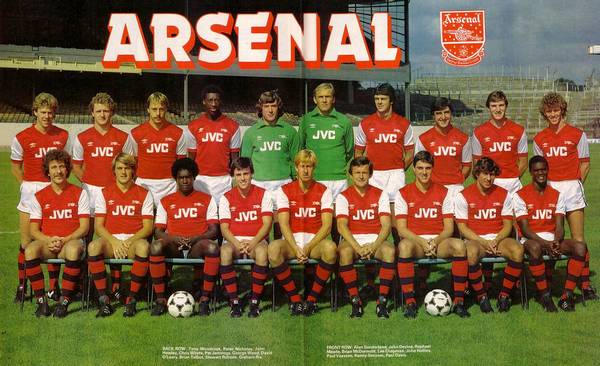
Arsenal FC 1982-83 team
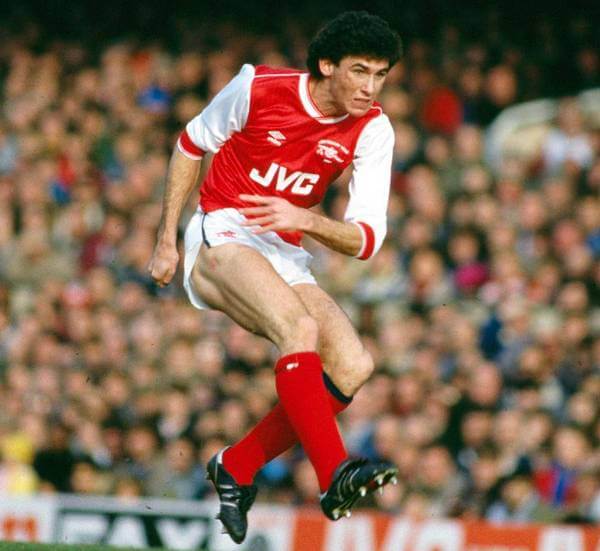
Arsenal FC Martin Keown 1985
The rest of the Seventies did not yield any trophies for Arsenal until 1979 when they won the FA Cup. This was a very important game for the club as the football team had lost the two previous FA Cup finals against lesser opposition. This time they faced Manchester United, and gave away a two goal lead in five minutes before sealing the victory in extra time.
The manager George Graham’s Era from 1986
After victory in 1979, the rest of the decade did not have any standout results. However, in 1986, the year of the Centenary celebrations, a very important decision was made: the appointment of George Graham as manager of Arsenal Football Club.
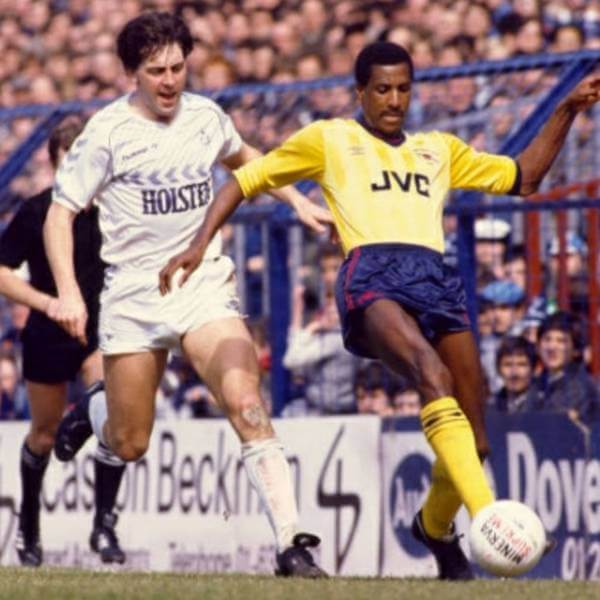
Within a year of being at the club, Graham had delivered a League Cup to Highbury. The Gunners were known for their defensive prowess under Graham, thanks to the strict discipline that he had instilled. One player represented this perfectly, the young captain Tony Adams.
With this rock solid back line that Graham had created, all the team needed was goals and these were delivered by players such as David Rocastle and Alan Smith. George Graham won his first title in charge of the Gunners in 1989, with one of the most famous and dramatic ends to the league ever.
Arsenal needed to win by two against rivals Liverpool who were favourites to complete their double. The Gunners were winning 1-0 but that was not rnough to clinch the title, until Michael Thomas burst through in the classic red shirt and deposited the ball into the net.
George Graham also signed some of the most recognisable players in Arsenal shirts ever. David Seaman will go down as one of the Gunner’s best keepers, with his long ponytail and his classic yellow shirt. Ian Wright, a player who breathes and lives Arsenal, was signed in 1991 for the club record signing at the time and he went on to become the all-time leading goal scorer in his time.
In his time at the helm of the Arsenal football team, Graham managed to win two league titles, in 1989 and 1991, three League Cups, one FA Cup in 1993 and a European Cup Winner’s Cup in 1994 as well, making him on of the most successful managers of the twentieth century.
The manager Arsene Wenger’s era from 1996
Although two managers were in between Graham and Wenger, their influence and reputation can be matched by no other manager of Arsenal Football Club. “The Professor” arrived at Highbury in October 1996, and in his first full season, the Gunners did not only win the title, but also the FA Cup.
The first ever non-English Arsenal manager, Wenger brought a foreign flair to his role. He revolutionised Arsenal through his training sessions and his dietary innovations. His early teams dominated the league so much that all of English football changed because of this one man. Gone were the years of pints and full English breakfasts before games, Arsene Wenger had arrived.
The Frenchman won three league titles and seven FA Cups for the London club and is the most successful ever North London manager. The sight of Wenger marching up and down the touchline with his long coat will be fondly remembered by all Arsenal fans.
Thierry Henry
If there is one Frenchman who can compete with Wenger for the fans’ love, it is Thierry Henry. Signed by Wenger in 1999, many believe him to be the Premier League’s best ever player. He had an ability to take over an entire game and pull his team up through his flair and skill.
Seeing Henry go through on goal in the classic red shirt could only have one result: a goal. He would either open up his body to curl the ball into the opposite corner or slide it past the keeper, and his impact on English football was gargantuan.
The initial Dial Square Football Club of 1886 has turned to be one of the most important football clubs in the world and one between the largest supporters base teams. Its long history of triumphs and legends has always the impulse ot its motto Victoria Concordia Crescit" ("Victory Through Harmony").
 Retrofootball
Retrofootball  Belgium
Belgium  France
France  Germany
Germany  Italy
Italy  Portugal
Portugal  Spain
Spain  Switzerland
Switzerland  United Kingdom
United Kingdom  other countries
other countries  Retrorugby
Retrorugby 
